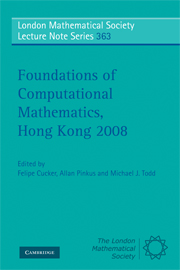Book contents
- Frontmatter
- Contents
- Preface
- Contributors
- 1 Smoothed Analysis of Condition Numbers
- 2 A World of Binomials
- 3 Linear and Nonlinear Subdivision Schemes in Geometric Modeling
- 4 Energy Preserving and Energy Stable Schemes for the Shallow Water Equations
- 5 Pathwise Convergence of Numerical Schemes for Random and Stochastic Differential Equations
- 6 Some Properties of the Global Behaviour of Conservative Low-Dimensional Systems
- 7 A Panoramic View of Asymptotics
- 8 Tractability of Multivariate Problems
5 - Pathwise Convergence of Numerical Schemes for Random and Stochastic Differential Equations
Published online by Cambridge University Press: 07 September 2011
- Frontmatter
- Contents
- Preface
- Contributors
- 1 Smoothed Analysis of Condition Numbers
- 2 A World of Binomials
- 3 Linear and Nonlinear Subdivision Schemes in Geometric Modeling
- 4 Energy Preserving and Energy Stable Schemes for the Shallow Water Equations
- 5 Pathwise Convergence of Numerical Schemes for Random and Stochastic Differential Equations
- 6 Some Properties of the Global Behaviour of Conservative Low-Dimensional Systems
- 7 A Panoramic View of Asymptotics
- 8 Tractability of Multivariate Problems
Summary
Abstract
Itô stochastic calculus is a mean-square or L2 calculus with different transformation rules to deterministic calculus. In particular, in view of its definition, an Itô integral is not as robust to approximation as the deterministic Riemann integral. This has some critical implications for the development of effective numerical schemes for stochastic differential equations (SDEs). Higher order numerical schemes for both strong and weak convergences have been derived using stochastic Taylor expansions, but most proofs in the literature assume the uniform boundedness of all relevant partial derivatives of the coefficient functions, which is highly restrictive. Problems also arise if solutions are restricted to certain regions, e.g. must be positive and the coefficient functions involve square roots.
Pathwise convergence is an alternative to the strong and weak convergences of the literature. It arises naturally in many important applications and, in fact, numerical calculations are carried out pathwise. Pathwise convergent numerical schemes for both SDEs and random ordinary differential equations (RODEs) will be discussed here. In particular, we see that a strong Taylor scheme for SDEs of order γ converges pathwise with order γ – ∈ for every arbitrarily small ∈ > 0 under the usual assumptions. We also introduce modified Taylor schemes which converge pathwise in a similar way, even when the coefficient derivatives are not uniformly bounded or are restricted to certain regions. In particular, these schemes can be applied without difficulty to volatility models in finance.
- Type
- Chapter
- Information
- Foundations of Computational Mathematics, Hong Kong 2008 , pp. 140 - 161Publisher: Cambridge University PressPrint publication year: 2009
- 3
- Cited by



